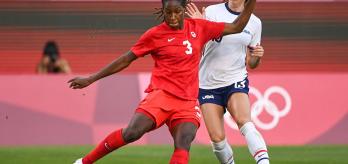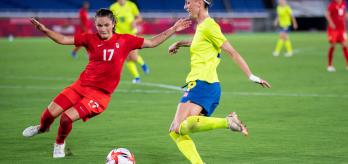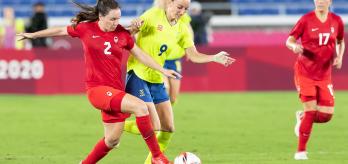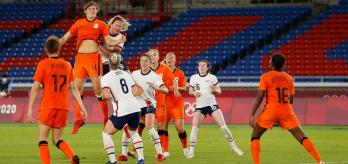Intensive high press
Sweden, Great Britain, the Netherlands and the USA are amongst the teams that employed a high press as they pushed deep into the opposition’s half and forced the goalkeeper to play short. In order for this aggressive strategy to be effective, two or three strikers need to lead the press in the final third, with the midfield line following closely behind. These teams’ full-backs also pushed forward so as to cut off the option for the opposition to play the ball into their midfielders.
By orientating strikers and midfielders in a certain way, in the press teams could create density in the chosen areas of the pitch, forcing the opposing team to build-up on a particular side.
Channelling opposition build-up wide
Of these proponents of the high press, Sweden’s variation was particularly impressive. When a team chose to play out from the back against Sweden’s high block, the Blågult managed to dictate the direction in which the opposition built up the play. The Swedish strikers targeted and pressed one of the opposition’s split centre-backs, denying any further progression on that defender’s side of the pitch and forcing the opposition to progress the build-up down the opposite channel. In what was arguably one of the matches of the tournament, against the USA, Stina Blackstenius (number 11) aggressively pressed the right centre-back, directing the build-up along the opposite left channels, where the US players would encounter Sweden’s dynamic duo of Sofia Jakobsson (10) and Hanna Glas (4).
Channelling opposition build-up centrally
The tournament’s other finalists and eventual winners, Canada, regularly adopted a unique inverted version of Sweden’s pressing tactic. Instead of forcing the opposition’s build-up play into the wide channels, the Canadian press directed the play through the central and inside channels, where their opponents were confronted by Canada’s formidable diamond midfield. Within this set-up, the Canadian forward pairing cut off the option of playing through the wide channels by deliberately curving their runs towards the ball. Canada’s full-backs also pushed forwards into midfield so as to further limit the opposition’s passing options and give them no option but to play out through the middle.
Compact mid-press
Meanwhile, some of the tournament’s participating teams, such as Japan and Brazil, tended to operate a mid-press. Although in certain situations they switched to a high press (for example, when the opposition played a backwards pass), both of these sides predominantly sat in a compact block around the halfway line. In a departure from the high press, where teams seek to turn possession over in the final third, sides adopting a mid-press openly invite the opposition to build up in their own half. It was only once the play reached the midfield that players pressed with real desire to win the ball. One major benefit for the teams operating this type of press is that they set themselves up closer to their own goal. This prevents them from stretching out too much over the length of the pitch, which can leave spaces for the opposition to exploit.









